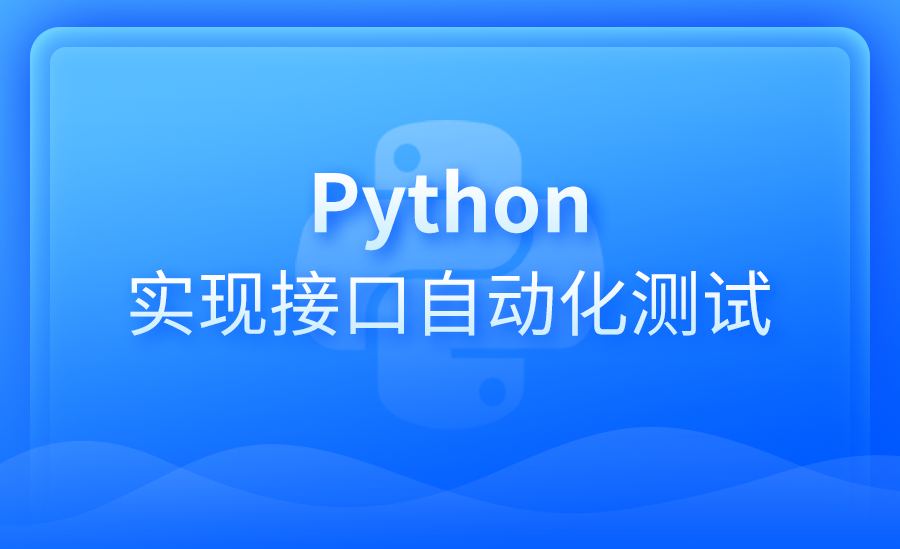在线客服

扫描二维码
下载博学谷APP
扫描二维码
关注博学谷微信公众号
Pytest作为一个Python测试框架,不仅简单灵活,新手也可以快速入门,而且具有很多的第三方插件,功能十分强大。因此,Pytest可以说是测试行业从业者必学的工具。本文将为大家介绍Pytest的安装、基本操作、运行时设置,以及参数化,下面一起来拿看看Pytest快速入门使用说明手册吧!

1、安装
(1)全局安装
使用pip 进行安装
pip install -U pytest
检查安装版本
$ pip install -U pytest
This is pytest version 4.4.0, imported from xxxx
(2)项目目录下安装
如果只是将pytest安装到当前项目中,不与其它的版本混淆,使用 virtualenv进行安装
mkdir pytest_project
cd pytest_project
virtualenv .venv
这将会在项目目录下创建pytest-env目录存放虚拟环境。
激活虚拟环境
source .venv/bin/activate
再次使用pip进行安装,安装文件将存放在当前项目目录下,而不再是全局环境变量下
$ pip install pytest
(3)区别
全局安装方式适合所有项目,在项目目录下虚拟化安装只适合当前项目。
2、基本操作
(1)主要内容
基本使用方式:我们将从一个简单的测试开始,Pytest命名规范文件名以test_开头或以_test.py结尾。首先创建一个名为test_capitalize.py的文件,在此文件中编写一个名为capital_case的函数,以字符串作为参数,将参数转化为大写返回。另外编写一个test_capital_case参数函数,主要验证capital_case函数完成它所说的内容,我们用test_作为测试函数名称的前缀。
# test_capitalize.py
def capital_case(x):
return x.capitalize()
def test_capital_case():
assert capital_case('semaphore') == 'Semaphore'
在命令行运行 pytest , 将自动执行 test_capitalize.py 文件中的 test_capital_case 测试方法;
collected 1 item
test_capitalize.py . [100%]
========================================= 1 passed in 0.01 seconds ==========================================
测试用例执行通过。
3、Pytest 运行时设置
(1)xunit 格式
函数级别设置运行时
setup_module
setup
teardown
teardown_module
如下代码
def setup_module():
print("module --setup-- ")
def teardown_module():
print('module --teardown--')
def setup():
print("function --setup--")
def teardown():
print("function --teardown--")
def test_01():
print("---test01---")def test_02(): print('-----test02------')
运行文件 pytest -s -v tmp.py
testcases/tmp.py::test_01
module --setup--
function --setup
-----test01---
PASSED function --teardown--
testcases/tmp.py::test_02
function --setup--
-----test02------
PASSED
function --teardown--
module --teardown--
Class 类级别
tmp2.py
class TestTmp2:
@classmethod
def setup_class(cls):
print('- class setup -')
@classmethod
def teardown_class(cls):
print('- class teardown - ')
def setup(self):
print('- method setup -')
def teardown(self):
print("- method teardown -")
def test_01(self):
print("-- test01 --")
def test_02(self):
print('-- test02 --')
pytest -s -v tmp2.py
tmp2.py::TestTmp2::test_01 - class setup
-- method setup -
-- test01 --
PASSED- method teardown -
testcases/tmp/tmp2.py::TestTmp2::test_02 - method setup -
-- test02 --
PASSED- method teardown -
- class teardown -
(2)fixture
函数级别
tmp.py
import pytest
@pytest.fixture(scope='module')
def fix_module():
print('-- module setup --')
yield
print('-- module teardown --')
@pytest.fixture()def fix_func(fix_module):
print('-- func setup --')
yield
print('-- func teardown --')
@pytest.fixture()def fix_func2():
print('-- func2 setup --')
yield
print('-- func2 teardown --')
def test_01(fix_func):
print('-- test 01 --')
def test_02(fix_func2):
print('-- test 02 --')
scope="module", module 级别
yeild 关键字
class 类级别
import pytest
@pytest.fixture(scope='module')
def fix_module():
print('-- module setup --')
yield
print('-- module teardown --')
class TestTmp2:
@pytest.fixture()
def fix_func(self, fix_module):
print('-- func setup --')
yield
print('-- func teardown --')
def test_01(self,fix_func):
print('-- test 01 --')
def test_02(self,fix_func):
print('-- test 02 --')
pytes -s -v tmp2.py
tmp2.py::TestTmp2::test_01 -- module setup --
-- func setup --
-- test 01 --
PASSED-- func teardown --
tmp2.py::TestTmp2::test_02 -- func setup --
-- test 02 --
PASSED-- func teardown --
-- module teardown --
tmp2.py
import pytest
@pytest.fixture(scope='module')
def fix_module():
print('-- module setup --')
yield
print('-- module teardown --')
@pytest.fixture(scope='session')
def fix_session():
print('-- session set up --')
yield
print('-- session teardown --')
@pytest.fixture(scope='class')
def fix_class():
print('-- class set up --')
yield
print('-- class tear down --')
@pytest.fixture(scope='function')
def fix_function():
print('-- function set up --')
yield
print('-- function tear down --')
@pytest.mark.usefixtures('fix_session','fix_module','fix_class' ,'fix_function')
class TestTmp2:
def test_01(self):
print('-- test 01 --')
def test_02(self):
print('-- test 02 --')
● session: 所有
● module: 整个文件
● class:类
● function:方法
testcases/testfixture/tmp2.py::TestTmp2::test_01
-- session set up --
-- module setup --
-- class set up --
-- function set up --
-- test 01 --
PASSED-- function tear down --
testcases/testfixture/tmp2.py::TestTmp2::test_02
-- function set up --
-- test 02 --
PASSED-- function tear down --
-- class tear down --
-- module teardown --
-- session teardown --
conftest.py 多个文件共享
4、参数化
(1)mark.parametrize
import pytest
a = [
('share','title1','conent1'),
('share','title2','conent2'),
]
@pytest.mark.parametrize('tab,title,content',a)
def test_a(tab,title,content):
print('----',tab,title,content,'-----')
(2)fixture 级别的参数化
import pytest
@pytest.fixture(params=[0,1],ids=['spam','ham'])
def a(request):
return request.param
def test_a(a):
print(f'--{a}--')
# assert a
def test_b(a):
print(f'=={a}==')
以上就是Pytest快速入门使用说明手册的全部内容,大家如果觉得本文对你有帮助,不妨把文章分享出去,让更多的人看到~
— 申请免费试学名额 —
在职想转行提升,担心学不会?根据个人情况规划学习路线,闯关式自适应学习模式保证学习效果
讲师一对一辅导,在线答疑解惑,指导就业!
相关推荐 更多

软件测试工程师必须了解的七大原则
之前有同学问我,软件测试的工作是不是只要将技术学习扎实,不需要过多的学习理论就可以职场上一马平川呢?其实并不是这样的。无论是哪个行业哪个岗位,仅仅懂得技术只能胜任执行的工作。更多的需要掌握这项工作的原理理论以及思维模式。尤其软件测试行业,建立良好的测试思维以及测试理论是非常有必要的。下面我就和大家一起分享一下关于测试思维中七大原则:
10213
2019-08-07 18:11:25

软件测试怎么学比较快
如今,不少人抱着“软件测试怎么学比较快”这样的想法,这里不得不给你们泼泼冷水,软件测试这么好的的就业前景和薪资,如果可以速学岂不是人人都可以当软件测试员?速学不可靠,但是提高学习效率的办法还是有的,比如报培训班,最快也要半年。因为在学习初期,一个好的学习规划可以帮助你少走弯路,直接学完就可以上手工作。以下是小编整理的软件测试必须掌握的基础知识,大家可以先看看。
6808
2019-07-26 14:04:41

http接口性能测试流程 案例步骤分析
本文将告诉大家在编写一个http接口性能测试方案时,测试过程的关注点有哪些流程?其实大概可以分为五个步骤,即准备工作、测试计划、测试脚本设计与开发、测试执行与管理和测试分析。
8336
2019-08-13 19:35:06

软件测试要学多久?软件测试培训多长时间?
想转行的人都比较关心软件测试要学多久和软件测试培训多长时这样的问题,很多培训机构的培训课程学习需要4~6个月,如果零基础学习软件测试需要先打好基础时间长一些,有基础的学员相对学习更快一些。如果你是选择自学,软件测试要学多久根据个人的基础和学习能力学习周期差距就很大了。
8186
2019-08-22 15:16:44

完整的测试用例流程设计步骤
测试用例流程设计步骤,书写一套完整的测试用例过程中需要对用例都从测试计划、测试设计、测试开发、测试执行、测试评估五个维度进行测试流程设计。
11562
2019-12-16 17:05:10



